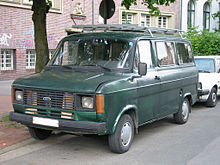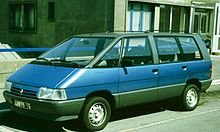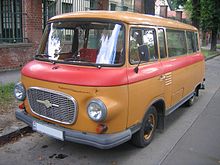minibus
Minibus is the name for a small van with windows and with up to nine seats including the driver's seat. Its chassis is mostly derived from a commercial vehicle or is being developed in parallel with it. Sometimes the term is also used for minibuses , which are vehicles of a similar design, but with a larger passenger capacity.
General
The term minibus originated in Germany in the 1950s with the introduction of the VW bus . Minibuses are designed to carry up to nine people. Due to the limitation of passengers and the weight of the vehicle, the minibus is still considered a car . According to the Road Traffic Regulations (Germany) it can therefore be driven by a driver with a car license and is usually taxed as a passenger car . The Federal Motor Transport Authority assigns minibuses to the Utilities segment . Minibuses often serve as the basis for the development of travel and mobile homes , and are now often in the trade press as Van called. Since the 1990s, vans have been developed that are no longer referred to as “minibuses” because of their compactness.
history
With the VW T1 , the first minibus based on the VW Transporter was introduced in Germany in 1950 . In addition to the standard "bus" version, which already had a higher-quality interior design compared to the simple van , with headlining and interior wall coverings, "special models" with upscale features were also initially brought onto the market as standard.
In the 1960s, Ford also brought out the Ford Taunus Transit, a minibus with upscale equipment, which, however, did not make a breakthrough on the market.
Since the beginning of the 1980s, minibuses from other manufacturers ushered in the change in the direction of comfort, so the Renault Espace was designed exclusively as an alternative to the passenger car; there was no Espace model for the commercial vehicle segment. The developers made sure that the minibus resembles a car in terms of equipment and handling. This development continued into the 1990s. With the Renault Espace, the concept of the MPV came up , and later the term van for this new vehicle class. From the fourth series onwards, the Renault Espace is no longer referred to as a minibus, as Renault has greatly reduced its dimensions.
In parallel with the trend towards minivans, manufacturers continue to design “real” minibuses for the transport of up to nine people; they are luxurious versions of commercial vehicles. In addition to minibuses, these manufacturers usually also have vans and minivans in their own range or in the range of a cooperation partner.
Well-known representatives of the class
- Barkas B 1000
- Citroën Jumper, Fiat Ducato, Peugeot Boxer
- Citroën Jumpy , Fiat Scudo , Peugeot Expert , Toyota Proace
- Ford Transit
- Mercedes-Benz MB 100
- Mercedes-Benz Sprinter , VW LT / Crafter
- Mercedes-Benz T 1
- Mercedes-Benz Vito / Viano / V-Class
- Nissan Primastar , Opel Vivaro , Renault Trafic
- VW Bus





